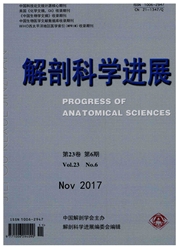

 中文摘要:
中文摘要:
目的研究金属螯合剂氯碘羟喹(Clioquinol,CQ)对小鼠大脑海马苔藓纤维内游离锌离子的螯合作用。方法3月龄雄性C57BL/6小鼠42只,随机均分为3组:正常对照组,溶剂对照组,CQ组。CQ组和溶剂对照组腹腔注射药物2h后与正常对照组一起断头取脑,制备小鼠海马冰冻切片,应用N-(6-甲氧基-8-喹啉)-P-甲苯磺胺(TSQ)荧光探针技术和金属自显影技术检测各组小鼠大脑海马苔藓纤维游离锌离子的分布和含量。结果CQ处理组小鼠海马苔藓纤维的TSQ荧光强度在CA3区及齿状回均明显低于正常对照组和溶剂对照组(P〈0.01),而两对照组之间无差别。CQ处理组小鼠大脑金属自显影阳性反应强度在皮层、海马CA3区、齿状回均明显低于正常对照组和溶剂对照组(P〈0.01),而两对照组之间无差别。结论金属螯合剂CQ对小鼠大脑内游离锌离子有明显的螯合作用,提示CQ可能作为锌离子诱导的神经细胞死亡疾病(如脑缺血和阿尔茨海默病)的潜在治疗药物。
 英文摘要:
英文摘要:
Objective To investigate the chelation effect of metal chelator clioquinol (CQ) on the free zinc ions in hippocampal mossy fibers of mouse brain. Methods 42 three-month-old male C57BL/6 mice were randomly and equally divided into 3 groups : the normal control group, the dimethyl sulfoxide (DMSO) control group and the CQ group. The CQ group and the DMSO group mice were injected intraperitoneally with CQ and DMSO respectively. Two hours later, brains of the three groups' mice were removed together and cryostat sections were prepared. TSQ fluorescence probe and immersion autometallography were performed to analyze the distribution of free zinc ions in mouse brain. Results Both TSQ histofluorescence and autometallography image indicated that the CQ group had a dramatic reduction of free zinc ions in hippocampal mossy fibers of mouse brain, compared with the normal control group and the DMSO control group (P〈0.01), but there was no statistical difference between two control groups. Conclusion The significant chelation effect of CQ on free zinc ions suggests that CQ might be a new therapeutic strategy for protecting against zinc-induced neuronal death in some diseases such as brain ischemia and Alzheimer's disease.
 同期刊论文项目
同期刊论文项目
 同项目期刊论文
同项目期刊论文
 Curcumin Prevents Dopaminergic Neuronal Death Through Inhibition of the c-Jun N-Terminal Kinase Path
Curcumin Prevents Dopaminergic Neuronal Death Through Inhibition of the c-Jun N-Terminal Kinase Path Regional differences in vulnerability of the cerebellar foliations of rats exposed to neonatal X-irr
Regional differences in vulnerability of the cerebellar foliations of rats exposed to neonatal X-irr Localization of ZnT7 and zinc ions in mouse retina - Immunohistochemistry and selenium autometallogr
Localization of ZnT7 and zinc ions in mouse retina - Immunohistochemistry and selenium autometallogr Axonal Transport of Zinc Transporter 3 and Zinc Containing Organelles in the Rodent Adrenergic Syste
Axonal Transport of Zinc Transporter 3 and Zinc Containing Organelles in the Rodent Adrenergic Syste Divalent metal transporter 1 is involved in amyloid precursor protein processing and A beta generati
Divalent metal transporter 1 is involved in amyloid precursor protein processing and A beta generati 期刊信息
期刊信息
